|
I will admit it right off the bat; I have a
weakness for single shot rifles. Not just any single shot rifle,
but those elegant designs with an under lever, such as the Ballard,
Sharps, Winchester High Wall, and the most modern
of the type, Ruger’s Number One. Ruger announced their
single shot in 1966, and ever since, it has had a loyal
following. With its clean lines and internal hammer, the Ruger
is one of the most elegant single shots ever built, reminiscent
of the old British single shots of years long gone.
Of the several variations of the Ruger Number
One, my favorite is the 1A, with its slender barrel, Henry
forend, quarter rib, barrel band sling mount, and open sights,
it just looks right, and handles like a dream.
As it happens, I also have a weakness for
thirty-five caliber rifles, whether it be the .358 Winchester,
.35 Remington, .357 Magnum, or even the large belted magnums.
However, my favorite thirty-five caliber rifle cartridge is the
grand old .35 Whelen. The Whelen was the result of an effort by Townsend
Whelen to make an affordable medium bore big game rifle out
of the US Military Springfield bolt-action. Enlisting the
help of machinist James Howe, the result is a .30-06 case
simply necked up to take .358 inch diameter bullets. The .35
Whelen is one of our most efficient medium bores, with ample
power to take any American big game, and flat-shooting enough to
do so out to 300 yards and beyond, if the shooter is capable.
If necessary, I could do any hunting that I will
likely ever do, including Africa, with the .35 Whelen and just
two different bullets. For medium game such as whitetail deer,
the same 200 grain Hornady Spire Point that I have grown
to love in my .358 Winchester is just about perfect. For
anything heavier, the Barnes 225 grain X bullet, in
either their coated XLC or uncoated Triple-Shok version, would
serve very well. The .35 Whelen can also use .357 caliber
handgun bullets for light game such as predators and vermin, or
even deer when properly loaded. Cast bullets also work
very well loaded to moderate velocities in the Whelen, but the
cartridge's forte lies in its ability to achieve good
performance on heavy game, at long range, and to do so very
efficiently, burning less powder and making less noise than with
some of its belted competitors. With a usable case capacity
pretty close to the .350 Remington Magnum, the Whelen
does best with powders in the medium burning range, such as IMR
and Hodgdon 4895, Accurate 2460, Hodgdon BLC(2)
and 335, and IMR 4064. I also achieved good results with
H322 and Varget in the .35 Whelen. On the slow side, I plan to
give H414 a go with some of the heavier bullets in the 250 to
300 grain range, although I do not see that they would offer
much advantage over the Barnes X 225. Being an homogenous copper
bullet, it always holds together well for excellent penetration,
and has a good ballistic coefficient for a relatively flat
trajectory. For those who do not load their own ammo,
Remington offers their excellent 200 grain Core-Lokt bullet
load, which should work very well on most game up to around 500
pounds, and Federal loads the 225 grain Trophy Bonded
bullet for anything heavier.
This particular rifle differs from most of
Ruger’s stainless Number Ones, in that instead of wearing a
laminated wood stock, this K1A wears a checkered walnut stock,
which is much more pleasing to my eye, and should also weigh a
bit less than the laminated version. The rifle has a slim
twenty-two inch barrel that measures just .577 inch just behind
the front sight barrel band. The contrast of the stainless and
walnut just does something for me! It is a fine looking rifle.
It has the Henry style forend, with the forward sling mount on a
barrel band, just as it should be on a rifle with a bit of
recoil. The pistol grip cap is also of stainless steel, with a
gold-colored Ruger eagle emblem insert. The buttstock wears a
firm synthetic rubber butt pad, and the rear sling swivel mount
is also of stainless construction. The only blued-steel parts on
the rifle are the open sights, with the rear being adjustable
for windage and elevation. The safety is right on top of the
tang, just as it should be, and is equally useable for either
left-handed or right-handed shooters. The trigger released
crisply and cleanly on the K1A, but measured a bit heavier than
I like at just over four and one-quarter pounds. The
sample K1A weighed in at just six and one quarter pounds, making
it a delight to carry, and to come up quickly to the shoulder
like a good bird gun. The wood-to-metal fit is very good
on the sample rifle, and the cut checkering is very well
executed.
Shooting the .35 Whelen presented a problem to
me, as I am still under doctor’s orders to not be pounding my
shoulders with recoil. For chronographing chores, I enlisted the
help of my brother Boge. He fired all of the test loads
over the PACT chronograph set at a distance of ten feet from the
muzzle. Being that I had Boge’s shoulder to wear out, I tried
several different loads, varying powder charge weights,
and powder and bullet types.
The Remington 200 grain factory loads
chronographed at 2617 feet-per-second (fps), and exhibited
excellent consistency. With the 200 grain Hornady Spire Point,
58 grains of Hodgdon Varget gave very good consistency and
relatively mild recoil with a bullet speed of 2583 fps. This
bullet can be pushed faster with H322 or H4895, but this load is
excellent for whitetail sized game, and is easy on the shoulder.
Another fine load was the Barnes 225 grain XLC pushed to 2707
fps with 57 grains of H322. However, the load using the same
bullet with 58 grains of H4895 clocked 2616 fps, and showed
better consistency. It was later proven to be a good choice on
the target range. A good cast bullet load used the Mt.
Baldy 250 grain gas checked lead bullet pushed to 2254
fps with 46.5 grains of H322. All loads used a Federal GM210M
primer. These loads showed no excessive pressure signs in the
test rifle, but have not been tested in any other. Do not try
these in an old converted Springfield!
When I began testing for accuracy, I had not the
use of Boge’s shoulder on those days. I tried a gun rest that
had been sitting in the barn for a couple of years that was sent
to me and advertised to take all the recoil out of shooting from
the bench. I gave it a try. The device might work well with a
bolt gun, but it had insufficient clearance underneath to open
the lever to load the Ruger. Having to remove it from the rest
made accuracy shooting a joke. The gun would not set in the rest
the exact same way every time, and the results were dismal.
Heading back inside, I decided to try a Caldwell Lead
Sled. However, due to the design of the rest, it presented the
same problem of having to remove the rifle to load, which
unseats the buttstock from the rear holder, and makes
consistency a lofty goal. I had to figure out a way that I could
use my Target Shooting Model
1000 rest. I have confidence in that rest more than any
other. I needed a way to use it, and to protect my shoulder at
the same time. I had Cousin Melvin to bend a car rear
axle spring for me to set behind the rest, going between my
shoulder and the buttstock. I bolted this to my bench with a PVC
cap to keep the Model 1000 centered, and the results were
perfect. I could shoot as I normally do, and have complete
control of the rifle. I was well-pleased with the accuracy
exhibited by the Number One. It proved capable of grouping three
shots into under one inch at 100 yards with my handloads, and
almost as good with the Remington factory load. The light
barrel heats up quickly on the little Ruger, but three-shot
groups are just fine to test a big game hunting rifle, and the
Number One proved capable of excellent hunting accuracy.
After accuracy testing, I fitted the Ruger with
what I believe to be the ideal scope for such a rifle capable of
hunting large game in the thick woods or at extended ranges; the
Leupold VX-II variable 2 to 7 power. The trim little
scope has ample eye relief, a good field of view, and plenty of
magnification for big game hunting. Set at two power, I can
shoot with both eyes open, and get on target very quickly. At
longer ranges, the seven power setting allows the shooter to see
his target and any obstacles well, allowing for a precision
shot. The excellent Ruger rings permit quick removal of
the scope should the need arise, and reattaching returns the
scope without the loss of zero.
I really like this K1A Ruger. It looks right,
feels right, handles quickly, and is a rugged, powerful, and
accurate choice for big game hunting. If you like to have a
magazine full of cartridges for backup, the Number One is not
for you. However, if you are of the attitude that you like to
make one well-placed shot count, with the knowledge that a quick
reload is possible with practice, this K1A could be a very
practical choice for a big game hunter. The stainless
construction is both beautiful and durable, especially for those
who hunt in wet coastal climates, such as Alaska. This would be
a very practical choice for an African bound hunter, offering a
classic style capable of taking all plains game easily. It is
also an excellent choice for a Southern hunter shooting 120
pound whitetails, but who knows that someday he might be found
hunting coastal Alaska and on the plains of the Dark Continent.
We all need a truly big game hunting rifle, even if a .243 will
do. There is just something about a good medium bore, and this
K1A is a beautiful example of what a big game rifle was meant to
be.
This .35 Whelen K1A is not a catalog item, but
is one of 250 made up for Lipsey’s, a distributor in
Louisiana. If you want one, you better have your dealer call
them now. Collectors are grabbing them up quickly. However,
these rifles are too good to be stored away like a gold coin or
one of those fancy jeweled ceramic eggs They should be carried
afield and enjoyed by shooters and hunters. They also have a
trim little blued steel .25-06 Number One that is exclusive to
Lipsey’s. Look for a review on it very soon.
Check out the full line of Ruger products
here.
Have your dealer contact Lipsey’s online
at: www.lipseys.com
or by calling 1-800-666-1333.
For the location of a Ruger dealer near you,
click on the DEALER LOCATOR icon at: www.lipseys.com.
Jeff Quinn
|
To locate a dealer where you can
buy this gun, Click on the DEALER FINDER icon at: |
|

|
  
Got something to say about this article? Want to agree (or
disagree) with it? Click the following link to go to the GUNBlast Feedback Page.
|
|
Click pictures for a larger version.
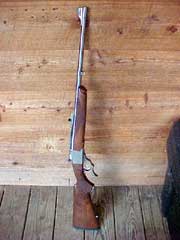
Limited .35 Whelen Ruger Number 1 Single Shot Rifle.
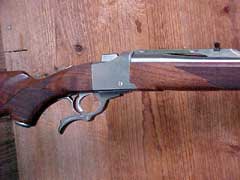
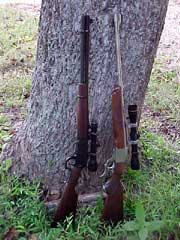
The Number 1 .35 Whelen is comparable in size to a
20-inch-barreled Winchester 94.
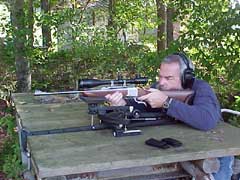
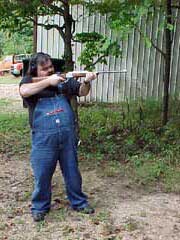
Both Jeff and Boge appreciated the handy size, power and
accuracy of the Number 1 .35 Whelen.
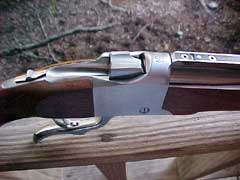
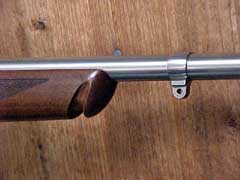
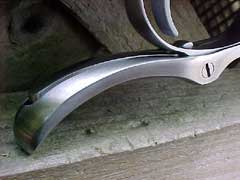
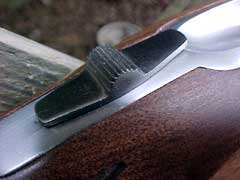
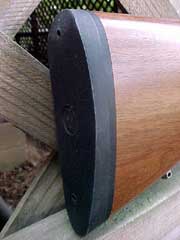
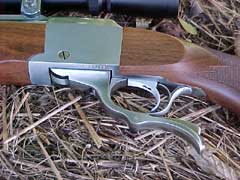
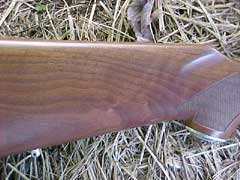
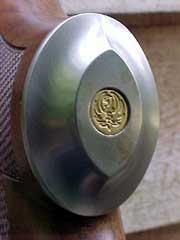
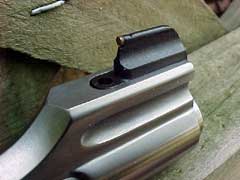
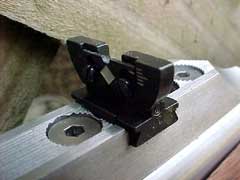
The Number 1 .35 Whelen sports a nice set of iron
sights, which is fitting for a big game rifle.
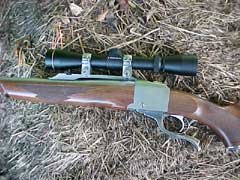
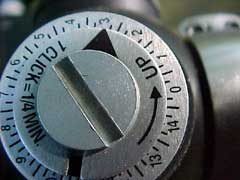
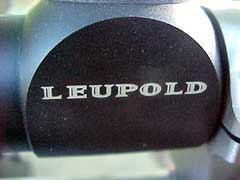
More precise long-range shooting requires quality
optics, and Leupold's VX-II scope proved perfect for the job.
The Ruger is supplied with scope mount and rings.
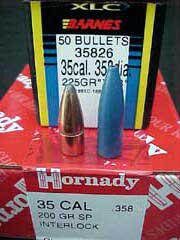
Author's favorite .35-caliber bullets.
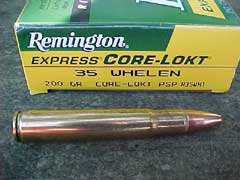
A good factory load for medium-sized game.
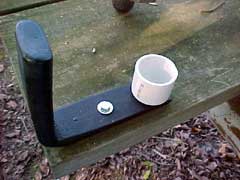
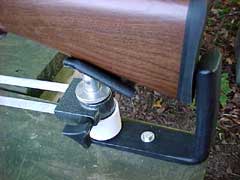
As Jeff is still recovering from coronary bypass surgery
and is still under doctor's orders to refrain from subjecting
his chest area to the effects of recoil, he installed this
simple but effective homemade recoil device to his shooting
bench.
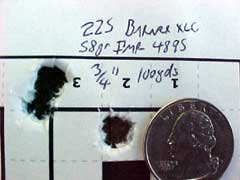
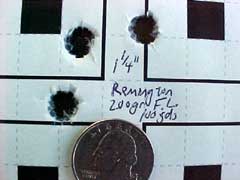
The Number 1 proved capable of fine accuracy with a wide
variety of loads tested.
|
![]()